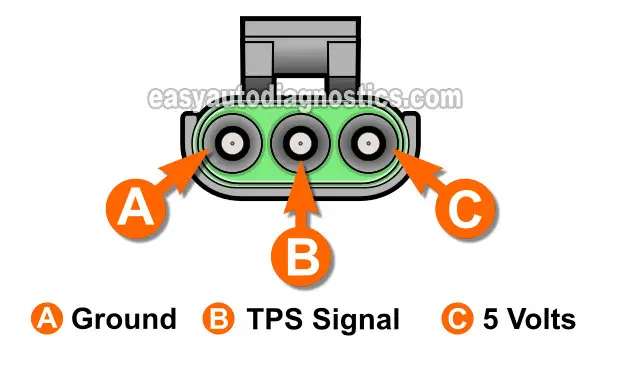TEST 2: Making Sure The TPS Is Receiving 5 Volts

The throttle position sensor requires 5 Volts DC and Ground to produce its variable output voltage signal.
The focus of this test section is to see if the TPS is getting 5 Volts from your pickup's fuel injection computer.
The wire that delivers these 5 Volts to the TPS is the gray (GRY) wire of the TPS sensor's 3-wire connector.
In the illustration above, I've labeled the terminal that connects to the GRY wire with the letter A.
Let's get started:
- 1
Select Volts DC mode on your multimeter.
- 2
Disconnect the TP sensor from its connector.
- 3
Probe the grey (GRY) wire with the red multimeter test lead and an appropriate tool.
The GRY wire is labeled with the letter A in the photo above.
NOTE: You can probe the front of the terminal with your multimeter test lead. Just be careful not to damage the female terminal. - 4
Connect the black multimeter test lead to the negative (-) battery terminal.
- 5
When everything is set up, have a helper rotate the key to its ON position but don't start the engine.
- 6
The multimeter should report 4.5 to 5 Volts DC.
Let's interpret your test results:
CASE 1: Your multimeter read 4.5 to 5 Volts. This is the correct test result and confirms the TPS is getting power.
Your next and last step is to see if the TPS is getting Ground. Go to: TEST 3: Making Sure The TPS Is Receiving Ground.
CASE 2: Your multimeter did not read the indicated voltage (4.5 to 5 Volts). Without these 5 Volts, the TPS will not function.
Although it's beyond the scope of this tutorial, your next step is to find out why this voltage is missing and restore it.
TEST 3: Making Sure The TPS Is Receiving Ground

This last test will help you determine if the TPS is getting Ground. Like the 5 Volts the TPS receives, the fuel injection computer also provides this Ground.
The wire that delivers this Ground is the black (BLK) wire of the TPS sensor's 3-wire connector.
In the photo above, I've labeled the terminal that connects to the BLK wire with the letter C.
To check for the presence of Ground in the black wire, we'll do a multimeter voltage test.
IMPORTANT: The fuel injection computer is the component that supplies Ground to the throttle position sensor. Be careful and do not short-circuit the Ground wire to 12 Volts or you'll fry the computer. The suggested multimeter voltage test is a safe way to test for the presence of Ground in the wire.
These are the test steps:
- 1
Select Volts DC mode on your multimeter.
- 2
Disconnect the TP sensor from its connector.
- 3
Connect the red multimeter test lead to the positive (+) battery terminal.
- 4
Rotate the key to its ON position but don't crank or start the engine.
- 5
Probe the black (BLK) wire with the black multimeter test lead and an appropriate tool.
The BLK wire is labeled with the letter C in the photo above.
NOTE: You can probe the front of the terminal with your multimeter test lead. Just be careful not to damage the female terminal. - 6
The multimeter should display 10 to 12 Volts DC.
Let's find out what your test results mean:
CASE 1: Your multimeter read 10 to 12 Volts. This is the correct test result and confirms the TPS is getting Ground.
You can conclude the TPS is bad if you have:
- Confirmed the TPS signal voltage does not increase/decrease as you open/close the throttle plate (TEST 1).
- Confirmed the gray wire is delivering 4.5 to 5 Volts (TEST 2).
- Confirmed the black wire is delivering Ground to the sensor (this test section).
CASE 2: Your multimeter DID NOT read the indicated voltage (10 to 12 Volts). This test result tells the TPS is not getting Ground and without it, the TPS will not function.
Although it's beyond the scope of this tutorial, your next step is to find out why Ground is missing and restore it.

If this info saved the day, buy me a beer!


